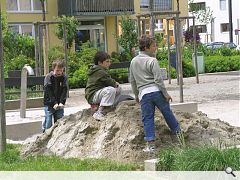Streets Ahead
7 Oct 2010
Page\Park's Chris Simmonds takes investigates the Home Zone concept:
In August 2008 one of the last public art installations was unveiled as part of the regeneration of the Gorbals at Queen Elizabeth Square. The 'Gorbals Boys' bronze sculptures devised by the Gorbals Arts project made real what Oscar Marzaroli had photographed in the Gorbals in the 1960s when he took a picture of three boys playing in their mother's high heels in the street. The populist nature of the sculpture generated more publicity than some of the other more conceptual pieces that had been produced as part of a Gorbals 'Artworks Masterplan' however the underlying message was every bit as profound. In casting, almost in memorial, three boys in bronze playing in the street, it highlighted as a society how we had lost our connection with public space.
Jumping to the present day we can see 'Placemaking' moving from the obsession of urbanists to official Government policy. The Scottish Government's 'Designing Places' and The UK Government's guide to PPG3 'Designing Better places to Live' both published around 2001 outline the ways that buildings should be defining good urban spaces. Masterplanning is seen as a key tool in ensuring the built environment meets up to the quality standards we seek and at its heart is the creation of high quality public space.
Parallel to this we have experienced a revolution in residential street design. It is now generally accepted that in residential areas speeds should be no faster than 20 mph and with the introduction of home zones and shared spaces to be ushered in under the new 'Designing Streets' legislation we will be seeing streets transformed from busy thoroughfares to 'outdoor rooms' for residents to spill out onto from their homes.
But while there is a growing consensus on the importance of public space and safer streets there has been less of a debate on what these public spaces and calmed streets are for. Indeed there is much confusion, now that we are bringing better public spaces in, on who should be allowed to use them and what they should do. Take the example of children Ð a potentially huge public space user group Ð how well do public spaces serve them? Children are generally segregated from public space with play being treated as only being allowed in designated zones. Quite rightly we have planning targets on how many play areas there should be in a given neighbourhood. All too often however they are realised in such an unimaginatively sterile manner with the proverbial 'play area with x number of items of play equipment' fenced off from wherever they are. The reality is that children will play anywhere with anything and will not naturally respond to arbitrary lines of definition in the way they are expected to.
Indeed the idea of dedicated equipment for play is again quite an artificial construct. At the generic fenced off play areas you encounter you're just as likely to see children swinging on the entrance-gates, as you are to see them swinging on the swings. Contrast this with some of the European examples realised in the last few years. In Freiburg many new housing developments feature a backcourt with landscaped common space which, while being a place for children to play does not rely solely on dedicated play equipment. Instead objects and landscaped features are placed which encourage play but at the same time function as attractive features in their own right. In one area a tree trunk is laid on the ground, in other areas there are big rocks and stepping-stones encouraging more imaginative play. On some days piles of sand will be deposited for children to play in.
There is a greater debate, however, on how society views children in public spaces. When we worked on the Home-zones in Craigmillar we had a very clear idea about how, by reducing traffic speeds down to near walking speeds the residents could feel empowered to walk, cycle and even play in the streets. When it came to discussing issues of 'Secured by Design' with the police we were surprised at how negatively they viewed the notion of children playing in the streets because of the possible conflict issues of 'a ball going over someone's fence' or hitting against someone's gable end. Indeed the idea of teenagers sitting in the square (presumably underage drinking) filled them with horror. Again if we look to the European examples we see a different picture. In the public spaces in Cadiz you would typically see children, young people adults and old people all sitting around, or playing or enjoying the space together. Admittedly there are a certain number of conditions unique to the place to make this happen: better climate, lack of space in apartments, high unemployment, good quality public spaces, but at its heart here is a society that values its public spaces and knows how to use them. There is a connection there to public space that we don't have.
Although we officially accept the need for better public spaces and denser urban environments, mentally there is a part of us that still harks back to the segregation and separation of the zoned city. One reason for this is the rise of 'paranoid parenting' where children aren't allowed out to play for fear of 'stranger danger' or concerns about the dangers of road traffic.
Another reason for this is that, in becoming a more affluent society, we have nicer homes to live in which we feel reluctant to leave. Underpinning this is an underlying political consensus that has viewed anything public as 'bad' and everything private as 'good'. There is a growing body of evidence to prove that all these isolating tendencies aren't making us as a society happier or healthier, quite the reverse, we are now in the grip of an obesity epidemic and, despite rising living standards, count ourselves no happier than 50 years ago.
The challenge then is not only to create attractive public places for buildings to be set in but for engaging public spaces for people to enjoy. For this as designers we need to think about how these places will be used throughout the day. We need to give opportunities for children to play informally and for adults to sit and observe. We need to create multi-functional spaces where sitting, playing, viewing, walking and cycling can all be done together. People need to feel empowered to influence the shape of their urban environment. Finally we need better maintenance and management of public space that has imagination as well as pragmatism.
The best mechanism for achieving this though may not be through the traditional means of state or local government but through individuals coming together to take control through residents associations or community factoring. Take the example of a backcourt area in London as part of a scheme by Circle 33 Housing Association. The residents have an overview on management and the space boasts a games area, sitting area, green space and landscaped space. There is informality about the way the games area isn't completely fenced off but is still well defined. The residents are responsible for contracting out wall maintenance and because they have a stake in the area they treat it intuitively like an extension of their own home. It is unlikely that a council could have delivered such a harmonious, charming space and maintained it so well.
With the looming presence of public sector cuts and recent election debates on localism and reigning back the state perhaps the idea of 'people-power' management of public space has come of age and may be the key to delivering the kind of actively used pubic spaces we so dearly need.
The above document is an edited transcript of the recent seminar 'Closer Encounters' held at Page\Park Architects. With thanks to contributions from Sue Gutteridge, Sheena Raeburn and Alistair King who's talks formed the basis for this article. Sue Gutteridge is a director of Playlink. Sheena Raeburn is an associate at Ian White Associates. Alistair King and Chris Simmonds are directors at Page\Park.




